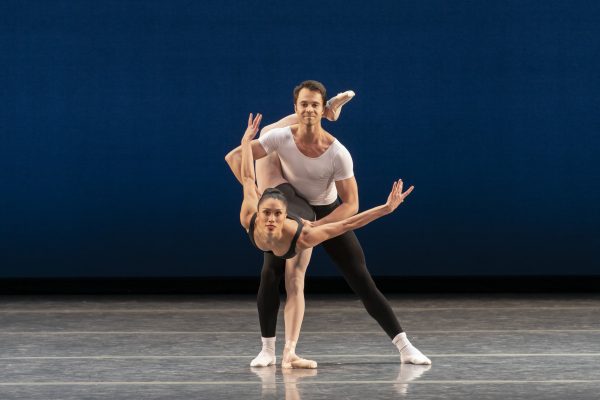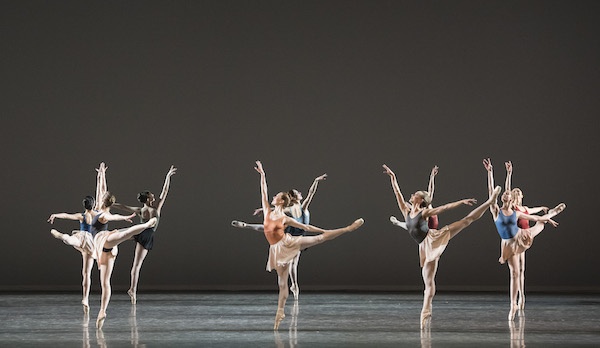Dance Review: Boston Ballet’s “rEVOLUTION” — The Art of Evolution
By Mary Paula Hunter
Boston Ballet’s rEVOLUTION is memorable because of its duel commitment: it is both enormously entertaining as well as edifying.
rEVOLUTION — Balanchine/Robbins/Forsythe, performed by Boston Ballet at Citizen’s Opera House, Boston, MA, through March 8.

Lia Cirio and Paulo Arrais in George Balanchine’s Agon. Photo: Liza Voll, courtesy of Boston Ballet.
A mixed bill evening of dance can send apprehensive shivers up my spine. All too often, varied programming serves no purpose, other than to fill two halves of an evening. Why open with this dance? Why close with that? A haphazard selection confuses audiences longing for clarity about this very misunderstood art form.
Kudos then to the Boston Ballet for mounting rEVOLUTION, a superbly curated concert of modern ballet. Works by Balanchine, Robbins, and Forsythe serve as a superb primer, representing the vitality of classical ballet since mid-century. In truth, eVOLUTION might be a more apt title for the evening, Ballet’s vocabulary continuously evolves and transforms while evolution is the life blood of modern dance. But regardless of the title, this program is memorable because of its duel commitment: it is both enormously entertaining as well as edifying.
What better way to pinpoint a seismic change in Ballet’s development than to open the program with Balanchine’s modern masterpiece, Agon? First performed by New York City Ballet in 1957, Agon announces in bold terms Balanchine’s intention to strip ballet of all of its 19th century style and manner. As the curtain rises we find four men, their backs to the audience, in black tights and white tee shirts. When they turn to face us with pulsing knees and eyes straight ahead we immediately understand that Agon, although structured after the forms of courtly dance, is no fairy tale.
Agon means contest in Greek and, throughout the collection of twelve dances, we realize that Agon‘s contest is between time and its companion, space. Two 20 century titans, Stravinsky and Balanchine, challenge each other, to go beyond the traditional coupling of movement and music. The conventional partnership, for example, is that big sound is paired with big movement while dainty music should be accompanied by the small jump combinations known as petite allegro. In contrast, Balanchine’s flexed feet, swinging arms, turns without preparation, and flurries of leaps answer (or counter) Stravinsky’s jagged rhythms and emphatic blasts of dissonance. Musical rests are responded to by barely contained activity in the tensile, ever-stretching bodies of the dancers. The choreography pointedly ignores the musical dynamic in favor of parallel, though qualitatively unrelated, sets of movement.
Each dance ends with movement and music in perfect synchronicity; it is as if the artists understood that, within limits, they could be endlessly inventive.
The radical nature of Agon is best expressed in the long pas de deux at the work’s center. As performed by Boston Ballet principals Lia Cirio and Paulo Arrais, the segment lacked the alacrity and daring that it demands, if you are to experience its revolutionary quality. After all, at the time (the 1950s), this was a new kind of conversation between the sexes. When the man displays his power through instant overhead lifts, the woman responds with extreme stretch-leg extensions that slice the air with a precision that projects it’s own strength and virtuosity.
Like the rest of the Boston Ballet cast, Cirio and Arrais danced the steps conscientiously, as if they felt the weight of history. Agon demands a bravery and commitment to full-throttle dancing that eluded these dancers.

Boston Ballet in Jerome Robbins’ Glass Pieces. Photo: Liza Voll; courtesy of Boston Ballet
Fortunately the company more than made up for this timidity in Jerome Robbins’ Glass Pieces and Forsythe’s In the Middle, Somewhat Elevated.
Fitted neatly between the radicalism of Agon and the post-modern off-kilter work that is pure Forsyth, Glass Pieces is an exploration of the kind of pedestrian movement that was first celebrated by ’60s modern dance. Robbins takes up the cause and the result is part West Side Story, part Peter Pan (Tiger Lily’s dance makes an appearance in the warrior style dance in the final section), and the nearly forgotten Watermill.
Glass’ music, music, over-used by choreographers, has never sounded fresher. Robbins takes four compositions and creates a different world for each piece. The opener features the entire company in what could be the vast space of a major subway station. Filled with travelers who barely miss each other in long traversing lines, the choreography creates a corps de ballet of the street.
The bold scene is refreshing but ultimately dehumanizing. At if to combat the isolation, a dancer breaks away, flying above the crowd and landing in the deep plie of a gymnast. At other times, dancers pivot in their sneakers like the Sharks and the Jets, only in this case these people are strangers changing direction, their eyes straight ahead. Three couples enter and the crowd takes up their movements — humans finally connecting in the urban landscape.
The second movement, performed to “Facades” is a sinuous pas de deux that was elegantly danced by Addie Tapp and Patrick Yocum. In bright tights and leotards they could be Adam and Eve or perhaps a utopian vision of the perfect couple. As always, Robbins eschews literal storytelling in favor of tone poetry that allows for multiple interpretations.
Behind the two dancers, a string of women pick their way across the stage, in simple, perfectly timed steps. They are like figures on a vase. Or could they be automatons from a dystopian future. Meditative in tone, this mesmerizing dance relates to another contemplative work Robbins choreographed in the ’70, Watermill.
The final percussive section from the opera Akhnaten is more Steve Reich than Glass. Here Robbins falls into the trap of imitating the thumping beat: this section is one-dimensional because it is all attack. Despite that, Glass Pieces is the highlight of this rEVOLUTION.

Viktorina Kapitonova in William Forsythe’s In the Middle, Somewhat Elevated. Photo: Liza Voll; courtesy of Boston Ballet
Rounding out the program is William Forsythe’s In the Middle, Somewhat Elevated. Choreographed to Thom Willems’ banging, ear-splitting score, the work is at times fascinating as it explores preparation and step — the hallmarks of ballet’s basic mechanics — but it is ultimately the least radical piece on the program because, as with any 19th century ballet, music dictates the work’s progression and its tone.
Dancers punch, contract, spin, and repeat. Soloist Tigran Mkrtchyan mesmerizes with liquid turns and explosive jumps. But the work’s sound and movement mirror each other so completely, the piece becomes dull and repetitious. By mid point, we have seen all it has to offer. When the music ends, the dance ends. What have we felt or learned? Little except that ballet can be brutal. The rather shop worn struggle between two women (the excellent Ji Young Chae and Viktorina Kapitonova) competing for the same guy isn’t all that compelling.
An evenness of tone undercuts In the Middle, Somewhat Elevated, but the dancers make it all worthwhile Forsythe may have forgotten Doris Humphrey’s dictum that every day is too long, but we could watch these technical wizards forever.
Mary Paula Hunter lives in Providence, RI. She’s the 2014 Pell Award Winner for service to the Arts in RI. She is a choreographer and a writer who creates and performs her own text-based movement pieces. In 2019 Hunter published Someone Else, a novel set in her hometown of East Lansing, Michigan.
